But be warned: Vietnam is quite a lot bigger than it may seem on a map at a glance, and your trip may involve a few long bus or train journeys.
Traveling the whole length of Vietnam is well worth the effort though, since the north and south are quite different from each other in terms of culture, geography, and climate. Night buses or night trains can help you cover some of the longer distances without losing much time. (You could also fly, but I would argue that going overland gives a stronger sense of a journey and can also be an experience in itself.)
There is a bit of a tried-and-true way route includes most of the top highlights in Vietnam, which I will explain to you here. Since I’ve been on multiple trips in Vietnam, I also offer suggestions on how to do things differently.
Plan your trip to Vietnam
How to Travel Independently in Vietnam
Vietnam may seem quite exotic if you haven’t been before (and it is), but it’s also quite easy to travel through. This is thanks in part to an extensive bus and train network, affordable accommodation, and plenty of tourism infrastructure.
Because of this, there is no really need to buy a complete holiday or fully organized tour for Vietnam. They are often highly overpriced and it’s better to plan your trip yourself.
Even with a budget tour operator like G Adventures, a 3-week Vietnam trip will still cost around $1700 or €1500 per person, but you could do it for as little as half the cost by doing it yourself. Don’t worry, even if you’re not that experienced of a traveller, you can survive in Vietnam!
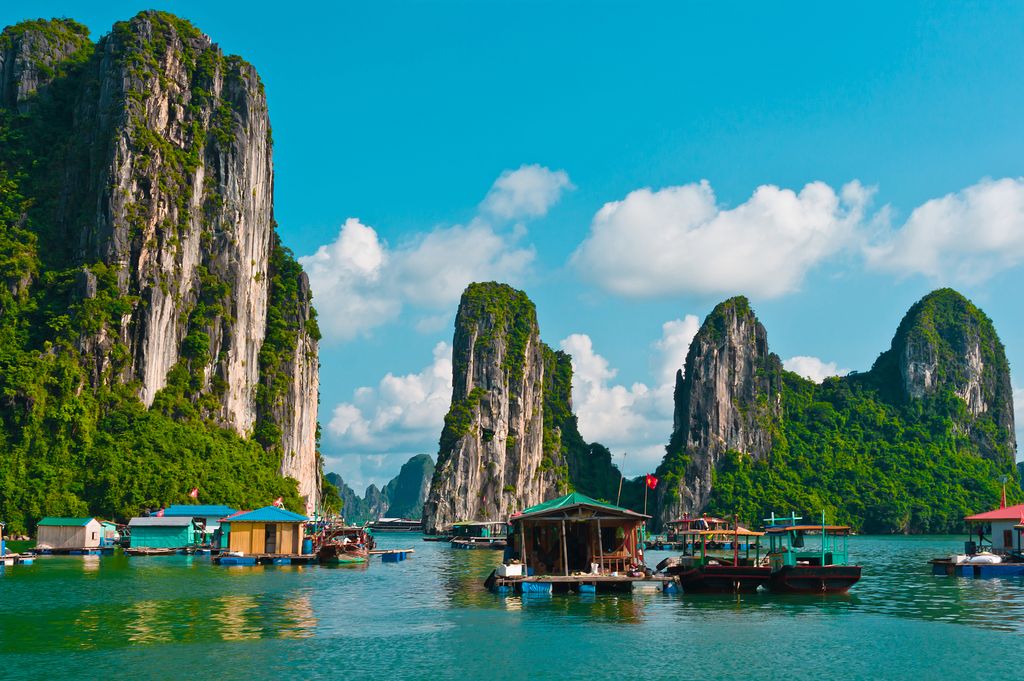
How to book your own trip
You can book your accommodation most easily via Booking.com, the Asia specialist Agoda, or via Hostelworld if you stay in hostels. It’s not usually necessary to book that far in advance, unless you are picky with your accommodation, so you can still improvise during your trip if you want.
Bus or train transport you can book locally using tour agents or hotel staff, or more easily via the Asia-specific booking site 12Go Asia. You can check more tips for booking transportation in Vietnam.
As far as local activities or tours go, the one that’s wise to pre-book before your trip is a cruise to Ha Long Bay. Many consider it the most epic sight in Vietnam, but the quality of the cruises varies quite a lot, so it’s a good idea to reserve a well-rated tour in advance.
How to book Ha Long Bay
Ha Long Bay is not a sight you can visit independently (unless you pack a boat!) and the experience can vary a lot based on the company you use. It’s worth pre-booking a high-rated tour, such as this one on GetYourGuide or this one on Viator. 2-day overnight cruises will give you a better experience than day trips.
A 3-Week Vietnam Itinerary
The following is a rough template for planning your Vietnam trip. This route starts in Ho Chi Minh City in the south and ends in Hanoi in the north, but you can also choose to do it in reverse order. I have included suggestions for activities and accommodation for each day.
| Day | Overnight | Activity |
| 1 | Ho Chi Minh Bliss Boutique Saigon |
Food tour or walking tour |
| 2 | Ho Chi Minh | Mekong Delta tour |
| 3 | Ho Chi Minh | War Remnants Museum |
| 4 | Dalat HouseChill Dalat |
Explore by motorbike |
| 5 | Nha Trang Aries Hotel |
Snorkeling tour |
| 6 | Nha Trang | Relax at the beach |
| 7 | Hoi An Little Hoi An |
Exploring the old town |
| 8 | Hoi An | My Son Sanctuary trip |
| 9 | Hoi An | Day trip to Da Nang |
| 10 | Hoi An | Relax at the beach |
| 11 | Hue HueNam Residence |
Temples & pagodas tour |
| 12 | Hue | Free time |
| 13 | Hanoi Silk Boutique |
Stopover before Ha Long Bay |
| 14 | Ha Long Bay | Ha Long Bay cruise day 1 |
| 15 | Ha Long Bay | Ha Long Bay cruise day 2 |
| 16 | Hanoi Silk Boutique |
Hanoi food tour |
| 17 | Hanoi | Exploring Hanoi by yourself |
| 18 | Sapa Chapa Ecolodge |
Visit markets & time to relax |
| 19 | Sapa | 1-day trek past terraced rice fields |
| 20 | Sapa | Free time |
Ho Chi Minh City (3 Days)
This itinerary begins in the former capital of South Vietnam, Ho Chi Minh City, which was formerly known as Saigon. Many Vietnamese will abbreviate it to HCMC so don’t be surprised if you see it written that way.
Ho Chi Minh City is the financial, economic, and cultural hub of southern Vietnam and as you might guess, it’s a bustling place. It has a vibrant energy about it, with tons of people and motorbikes everywhere. Crossing the streets can be quite something, although the locals seem to just glide through the traffic like it’s no one’s business.
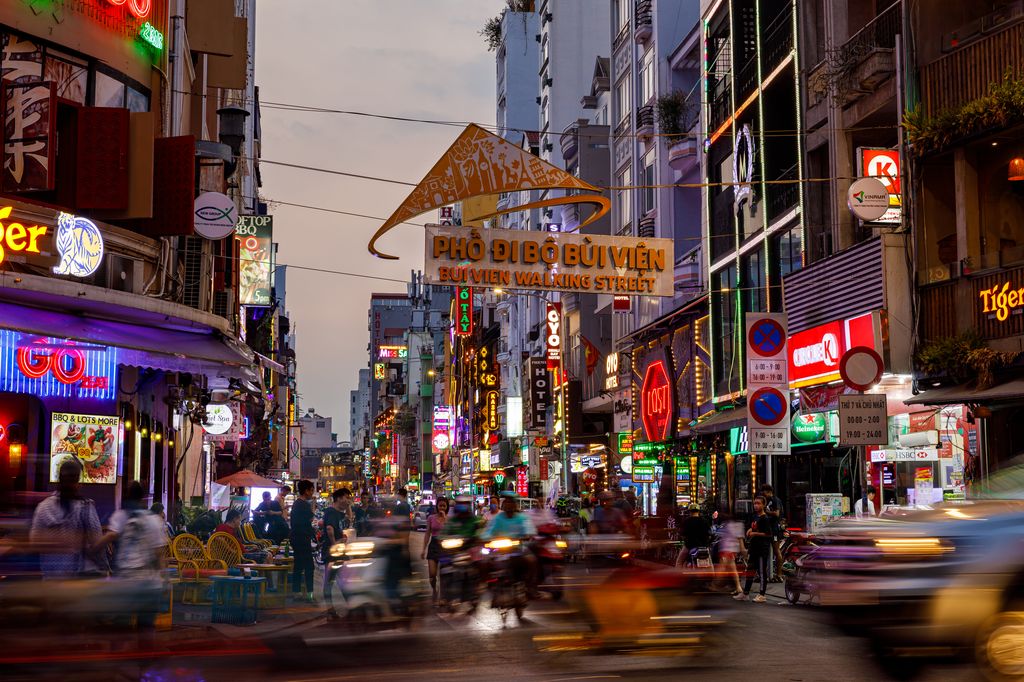
During a 3-day stay in Ho Chi Minh City, there’s plenty to do and see within the city and surroundings. It’s highly recommended to book two separate day trips that leave from within the city – one to the Mekong Delta and the other to the Cu Chi Tunnels.
Some of the highlights in Ho Chi Minh City include:
- War Remnants Museum – One of the more moving places to visit in Vietnam, this museum focuses on the events and atrocities of the Vietnam War (or, as it’s known locally, the American War). It’s a must-see and contains exhibits from the Vietnam War as well as the First Indochina War. Set aside at least a few hours to visit.
- Ben Thanh Market – A famous sight for tourists and locals alike. One of the longest-standing markets in the city and an important symbol in the city.
- Notre Dame Cathedral and Saigon Post Office – Located a stone’s throw from each other, both are commonly visited sites in the city. The Notre Dame Cathedral was erected by former French colonists in the 1800s.
- Cu Chi Tunnels – An organized day trip out to the Cu Chi Tunnels is something that cannot be missed. You will visit the famous tunnels that the Vietnamese used during the war, and learn all about the role they played.
- Mekong Delta – Lastly, it’s recommended to take a tour from the city down to the Mekong Delta. It’s a full day out exploring the area and learning about the way of life of the locals, typically including a trip to a floating market where sellers bring their goods on small boats in the river.
Dalat (2 Days)
Dalat, known as “the city of endless spring”, is located at a higher elevation and surrounded by waterfalls, pine forests, hills, and lakes.
It’s a literal breath of fresh air after Ho Chi Minh City with the temperate climate being much cooler and less humid.
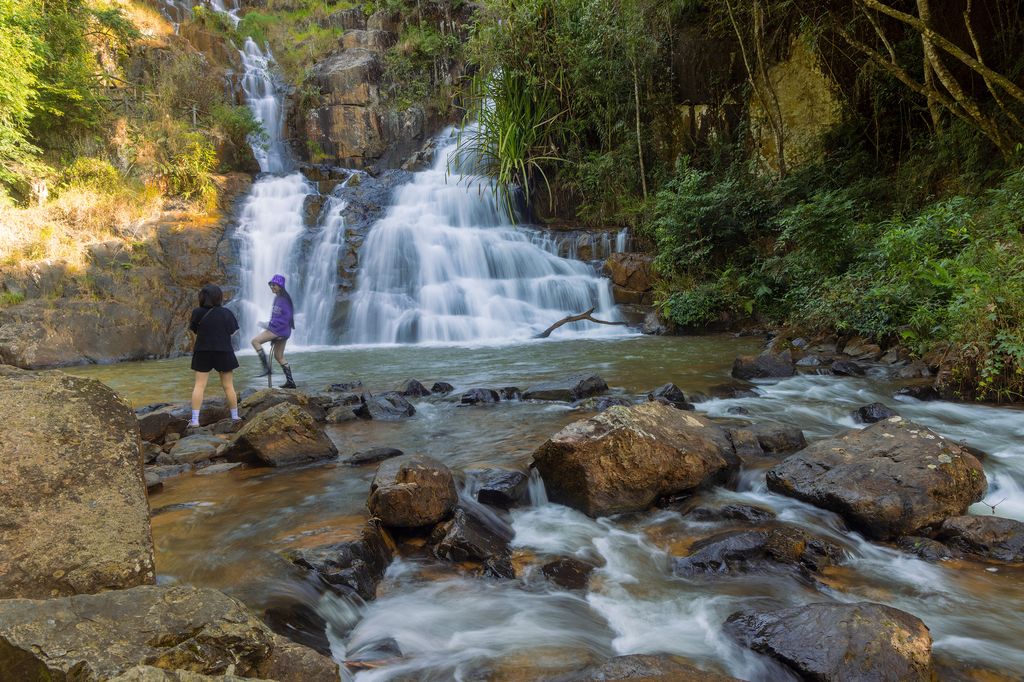
A bus is the perfect way to travel the 300-ish kilometers (200-ish miles) from HCMC and will take between seven and nine hours. There is also a range of day and overnight buses that will set you back between $8 – $18. Dalat is unfortunately not on the rail network, so taking a train is not an option on this leg of the journey. You can check all transport options to Dalat.
The surrounding area is most famous for its farming, especially fruit, vegetables, flowers, and coffee. There is plenty to see in Dalat, with some top sights in and around the city. Grab yourself a motorbike or bicycle and go exploring!
Dalat feels a bit like a cross between Vietnam and rural France, which is maybe not something many travelers expect to find. For this reason (and for the escape from the tropical heat) I think it’s really fun to add Dalat to your itinerary.
Some of the top things to see include:
- Dalat Night Market – Everything you can expect from a local Vietnamese market – bustling with vendors selling a range of products from fresh ingredients to food, and souvenirs.
- Crazy House – A unique guest house that was built as an exercise in creativity. You can also stay there in one of the ten guest rooms, each named after a plant or animal.
- Datanla Waterfall – A fun place to visit, just outside of the city. A series of waterfalls, hiking trails, and even a roller coaster – fun for a half-day trip. Alternatively, you can join this full-day tour, which also includes other interesting nearby places.
- Linh Phuoc Pagoda – One of the most famous pagodas in Dalat. It is rather unique with its dragon temple made out of 120,000 bottles that stand 7m high!
- Local Coffee Plantation – Dalat is a big producer of coffee in Vietnam, and you can visit one of these local coffee plantations just outside the city on this tour, which also includes Crazy House.
Nha Trang (2 Days)
Next up is the seaside city of Nha Trang, located just over 130 kilometers (80 miles) from Dalat. Again, it is recommended to take the bus to get to Nha Trang – a cheap trip with plenty of providers to get a ticket from in Dalat.
Nha Trang is known for its offshore islands, dive sites, and beautiful beaches with buzzing streets at night and a chilled beach atmosphere during the day. After an action-packed first week in Ho Chi Minh City and Dalat, it’s the perfect time to chill out and relax at one of the local beaches in Nha Trang.
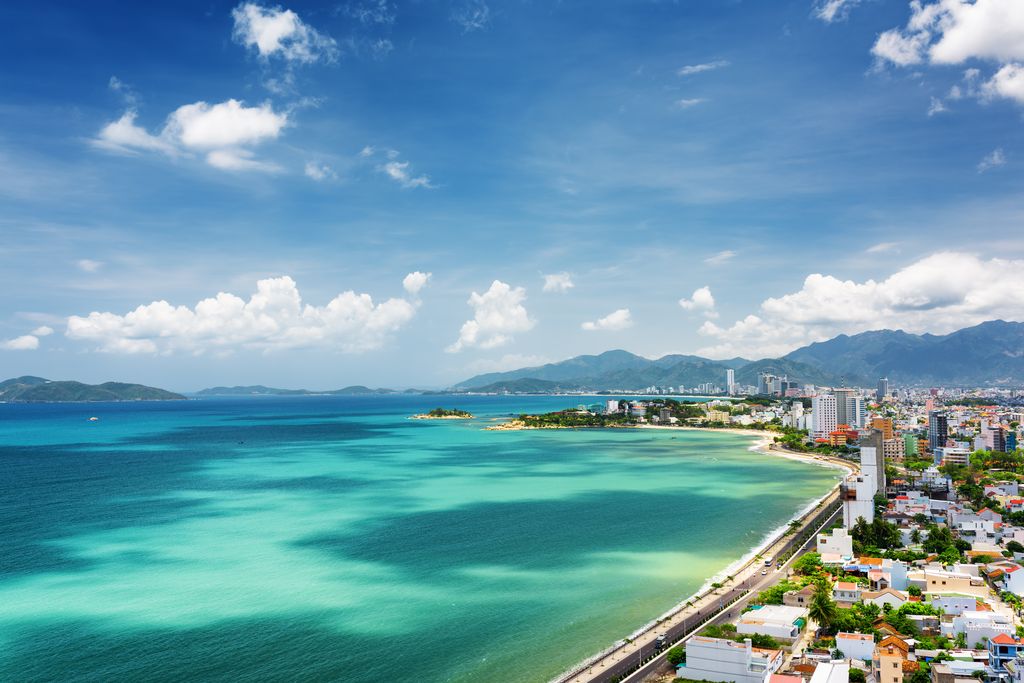
Aside from that, some of the top things to do include:
- Po Nagar Cham Towers – An active worship site for Chinese people, Cham, and Vietnamese Buddhists. Easily accessible and one of the most popular sites to visit in Nha Trang, a short commute from the city center.
- Thap Ba Mud Baths and Hot Springs – Mud baths are believed to have healing qualities due to their mineral contents. The Thap Ba mud baths are a great way to relax, cover yourself in mud, and let the healing begin.
- Snorkeling Tour – There are some nice dive sites off the coast of Nha Trang and companies that organize dives to them. The water isn’t too deep so it’s perfect for some snorkeling to see the coral and sea life in the Hon Mun Marine Protected Area.
Alternatives to Nha Trang
Nha Trang is the most common stop between HCMC and Hoi An, and it’s a perfectly good place to spend some time on a beach. It’s very much a large-scale coastal resort though, complete with a large waterpark and other commercial entertainment. There are fewer cultural sights and it’s very tourist-centered, targeting Russian tourists in the past but now increasingly Chinese tourists.
If it’s not your cup of tea, other beach places are a bit more chilled and authentic. Consider the island of Con Dao or head for the beaches of Quy Nhon. The nicest beaches in Vietnam are in Phu Quoc Island, bordering Cambodia, but since it’s a bit out of the way we left it out of this itinerary.
If the beach is not a priority for your trip, you could also cut out Nha Trang from your route and allocate these days elsewhere. Hoi An, which is coming up next, has quite a pleasant beach near it too.
Hoi An (4 Days)
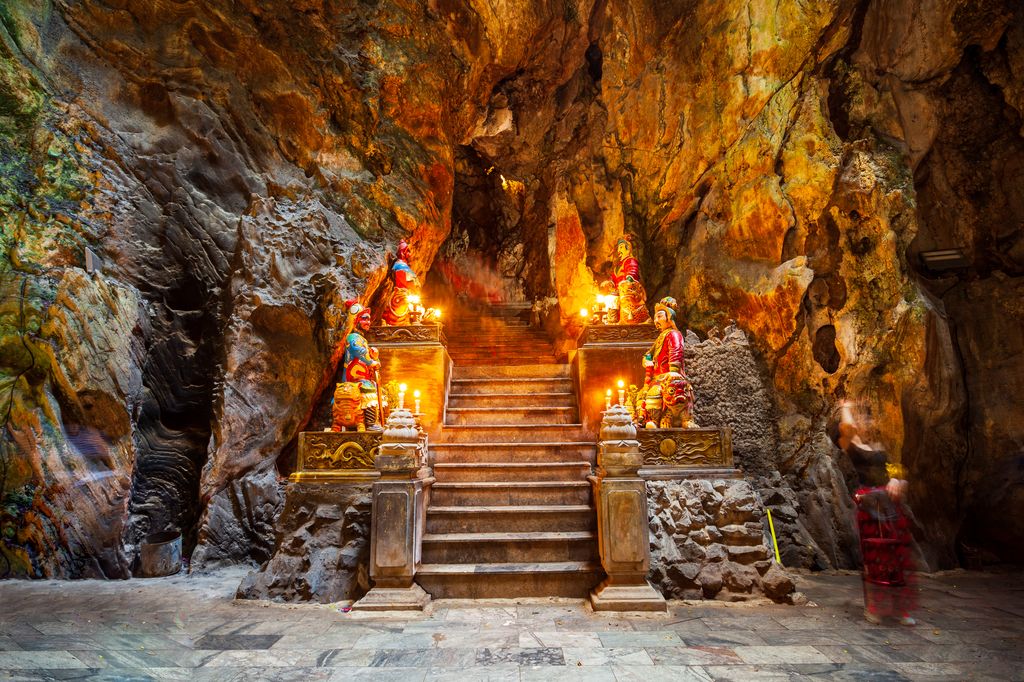
It’s on to the ancient city of Hoi An, a hefty 500ish kilometers (300ish miles) from Nha Trang. It’s a mere one-hour flight, but my recommended option is to go overland and take the overnight sleeper bus. Sleeper buses are a unique way to travel in Vietnam and kill two birds with one stone – your travel and accommodation. The journey takes around 11 hours and costs around $35 (VND 850,000). You’ll find more details on this overnight trip here.
Hoi An is one of the top destinations in Vietnam – and it’s easy to see why. There’s so much to do and see, from lantern-lit alleyways and quaint walks along the river to beautiful beaches and delicious food. While it can get super touristy at peak times, it’s possible to find your own little slice of peace and quiet, especially down at the beach.
The city of Da Nang is also a short ride away and is another place worth exploring. You can always rent a motorbike for the day and drive there – it’s a nice change of pace and scenery.
Some of the highlights of Hoi An include:
- Hoi An Central Market – The central market is a great place to pick up some local products as souvenirs. Things like local crafts, silk, and spices are readily available and you can also try some local cuisine like Cao Lau – a must-try when visiting.
- An Bang Beach – Another draw of Hoi An are the beautiful beaches which are just a short commute from the old town. Grab a bicycle, take a cycle through the rice fields, and head down to An Bang Beach for a spot of beaching.
- Attend a Cooking Class – Another fun thing to do in Hoi An is to attend a cooking class and learn how to make some of the traditional dishes. Classes normally start with a visit to the local market to pick up ingredients before the class begins.
- Have a Suit Tailored – Hoi An is famous for its textiles and tailoring, and it’s a popular thing to have a suit made when you visit. You can choose from one of the many stores as the streets are lined with them.
- Visit the Marble Mountains – A short commute from Hoi An are the Marble Mountains in Danang. The mountains feature caves, statues, and amazing viewpoints from the top.
Hue (2 Days)
The city of Hue (pronounced like ‘way’) is next up on this Vietnam itinerary. Once North Vietnam’s capital and home to the Imperial City. It’s a short 120-ish kilometer (75-ish miles) and is best done by bus, taking around three hours or so from Hoi An. You can check all transport options from Hoi An to Hue.
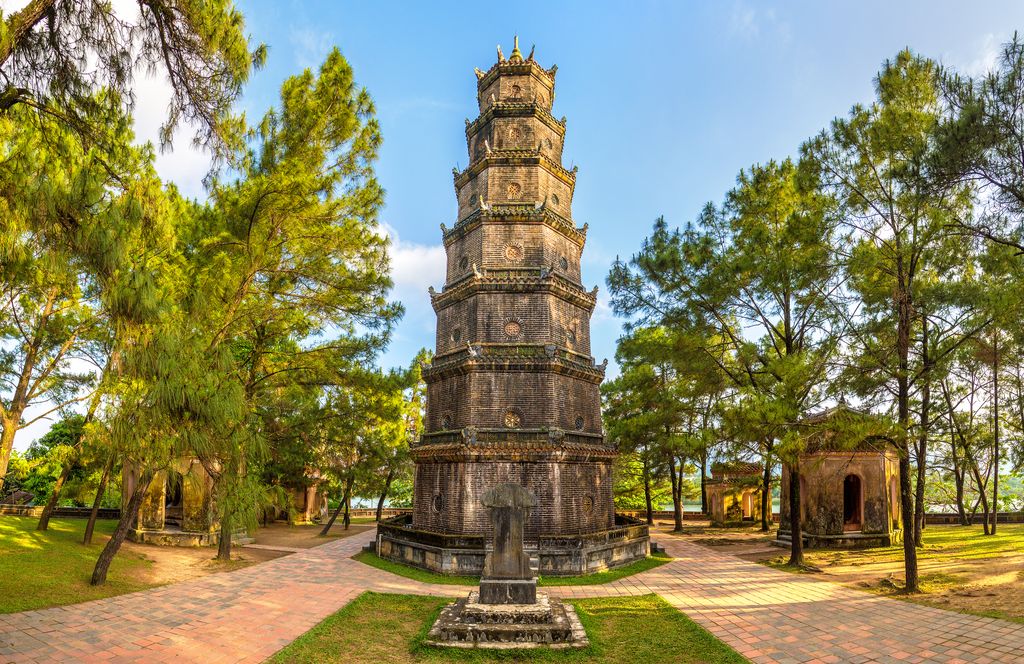
Hue is one of the more unique destinations to visit in Vietnam with its plethora of pagodas and mausoleums. Staying here shortens the distance to Hanoi which can be covered with an overnight bus or train. There are also some unique things to do in Hue and there’s a lot of history in the city.
Some of the attractions in Hue include:
- The Imperial City – The Imperial City is a recognized UNESCO World Heritage Site and makes for a great morning or afternoon of exploring. You can purchase a ticket on the day, and it allows you to explore the grounds of the Citadel.
- Abandoned Waterpark – One of the more unique things to do in Hue is explore the abandoned waterpark. Grab a rental motorbike and head out to explore the various rides that once saw many a visitor. You’ll need to give the security guard a little something to allow you in but it’s totally worth it.
- Thien Mu Pagoda – Take a walk up the seven-story-high pagoda and be treated to views of the river and pagoda gardens. Just pray that it isn’t a blistering hot day!
Alternatives to Hue
I think Hue is fantastic, which is why I include it here as the default place to go after Hoi An. However, it is very focused on sightseeing the many pagodas, tombs, and ruined temples, so if you’re not into such monuments you may not like it as much. I heard from some backpackers who felt it was not ‘as exciting’ as other places, which may be due to a lack of interest in the historical sites.
If you are looking for somewhere else to go, I do have another suggestion in central Vietnam. A bit further north you can find the small town of Phong Nha where you can visit numerous caves, including some of the world’s biggest. It’s a thrilling place to go caving, ziplining, and jungle trekking. If you’re looking for something more active, this is the place to go.
Ha Long Bay (2 Days)
Ha Long Bay is a UNESCO World Heritage Site and one of the most picturesque places in the entire country. I would recommend taking an overnight train from Hue to reach Hanoi by the following morning. It’s a lengthy distance just shy of 700 kilometers (just over 400 miles) but at least you can arrive early and hopefully well-rested.
Depending on when your Ha Long Bay cruise departs, you may want to spend one day in Hanoi before you set off.
The bay is dotted with more than 1,600 limestone islands, and the area is best to explore by means of an overnight boat trip. There are so many options available, but a two-day, one-night trip is one of the most popular options.
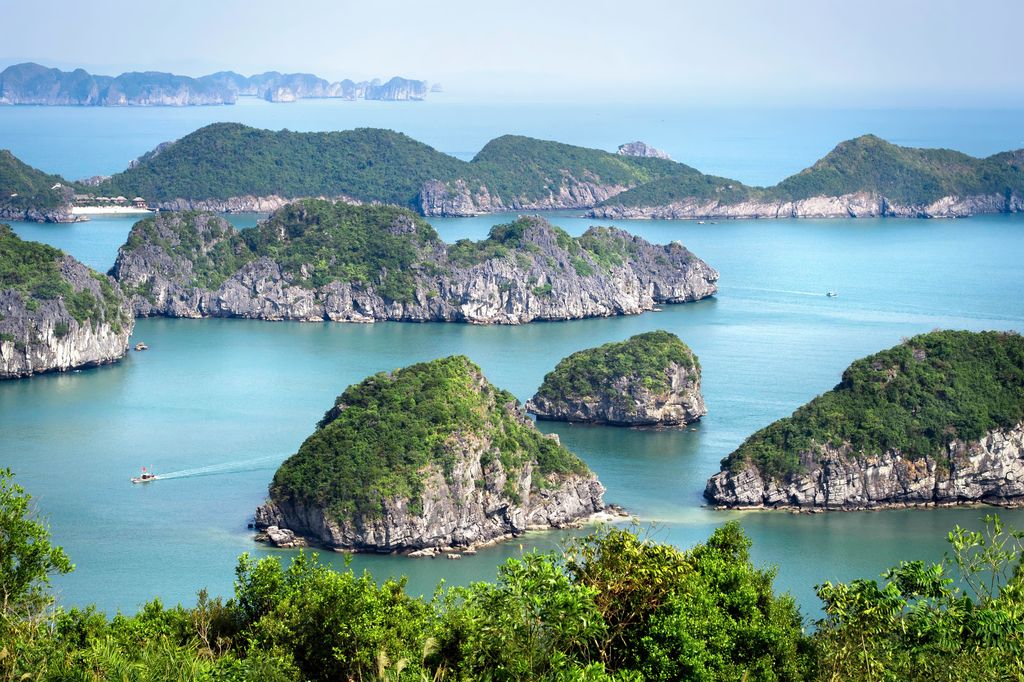
A typical boat trip involves a cruise through the bay, navigating the many limestone islands, cooking classes on board, kayaking and swimming, a cave visit, delicious buffet food, and perhaps even trying your hand at squid fishing at night. If you manage to catch one of the elusive mollusks, the chef will prepare your catch for you to eat!
The quality of the cruises differs hugely, from backpack-oriented trips with super cramped quarters up to lush luxury experiences. I recommend booking a tour with good reviews that will match your expectations. While I often recommend buying tours locally from an agent, in this case, you may want to research your options online.
I personally had quite a poor experience by booking just a random tour while in Hanoi. I’ve also heard varying reviews of Ha Long from other travelers that depended greatly on which provider (and type of boat) they went with. I recommend this mid-budget Ha Long Bay tour or this tour for a luxury option.
Ha Long Bay can be quite crowded and touristy, but with the right cruise, it is still an amazing experience in a very scenic place.
Some of the highlights of Ha Long Bay include:
- Visit Cat Ba Island – Cat Ba Islands can be added as an extra night onto most 2D1N trips and is definitely worth visiting if you have the time. Lush forests, pristine beaches, and beautiful bays await.
- Visit Dau Go Cave – Dau Go Cave is the largest cave in Ha Long Bay and has some pretty special natural limestone formations inside, including large stalagmites and stalactites.
- Visit Ti Top Island – After summiting some 450 steps to the top, the views that greet you are completely worth it. You can cool off with a dip once you reach the bottom again.
Alternatives to Ha Long Bay
I think most would consider Ha Long Bay a classic “must-see” in Vietnam, though the logical consequence of this is that it can also get quite crowded. If you consider yourself picky when it comes to touristy activities, there are two ways to do things a bit differently.
One is to take a cruise that goes a bit further to the much quieter and less developed Lan Ha Bay or Bai Tu Long Bay. You could also skip Ha Long Bay entirely and switch it for Ninh Binh, an area with huge karst mountain formations which some like to call “Ha Long Bay on land”. In an objective sense, it’s probably not quite as impressive, but you may find the experience a bit calmer in Ninh Binh.
Hanoi (3 Days)
Next up on the itinerary is the bustling city of Hanoi, Vietnam’s capital, after being dropped back off by your Ha Long Bay tour operator. The city is one of the busiest in the country, with a hustle and bustle that can be equal parts overwhelming and energizing. There is a beautiful mix of Chinese and French architecture, with the latter leaving behind a strong coffee and baguette culture.
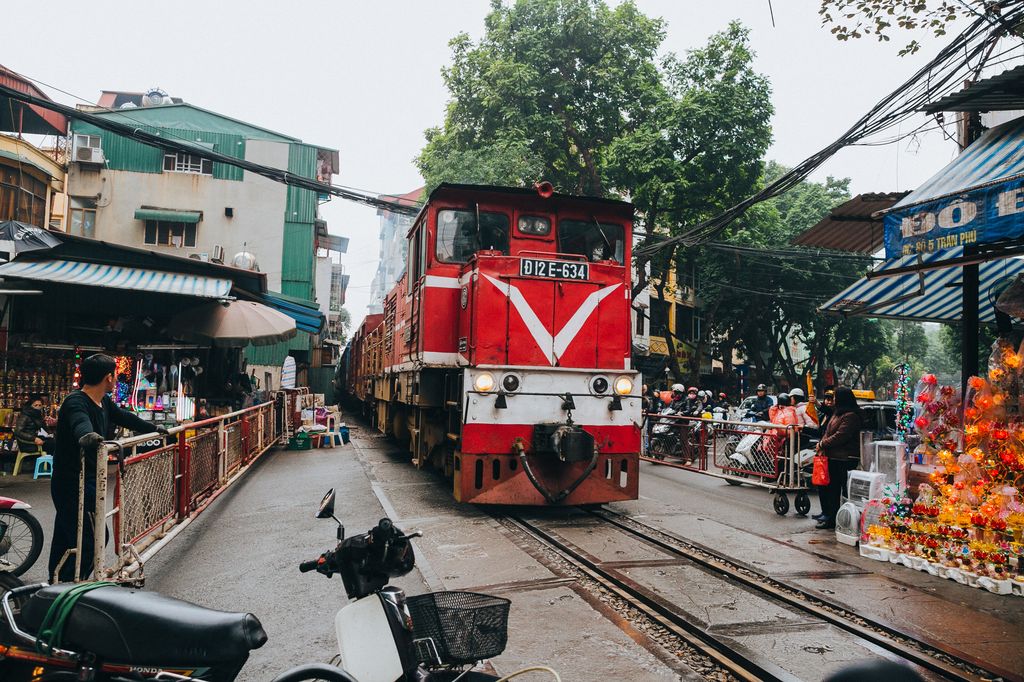
The Old Quarter is at the heart of the city, centered on Hoan Kiem Lake which is an iconic attraction. Hanoi has an incredible food culture and some of the most delicious cuisines in the entire country.
Some of the highlights of Hanoi include:
- Wander the Old Quarter – you can do and see so much in the Old Quarter from visiting Hoan Kiem Lake or trying an egg coffee to wandering through Ly Quoc Su Street and grabbing a banh mi or visiting St Joseph’s Cathedral.
- Take a photo at Train Street – The train literally snakes through houses and markets and is a popular spot for snapping a pic.
- Visit the Ho Chi Minh Mausoleum – The final resting place of Ho Chi Minh is in the Ba Dinh district and is a stunning place to visit at night.
Sapa (3 Days)
Last but definitely not least, is the town of Sapa in the mountainous northern stretches of the country. Sapa is best accessed from Hanoi, and you can take an overnight bus or train to travel the 300ish kilometers (190 miles). While the bus takes around five or six hours, the train takes a bit longer, around 8 hours to Lau Cai, and then a further hour by road to reach the village.
You can opt to stay in a hotel, as suggested in the earlier itinerary outline, but it’s even better to try and stay in the rural areas around Sapa.
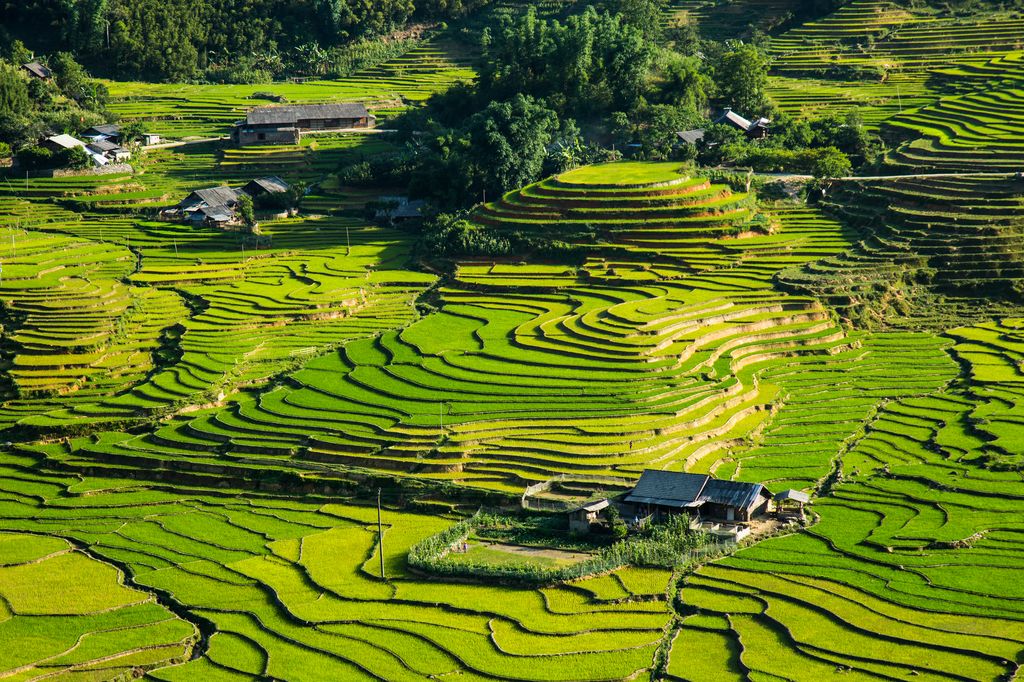
It’s typically best to organize a trip to Sapa through an agent, as it takes away the hassle of trying to book things separately. You will be picked up from your accommodation, transported by train or bus to Sapa, and stay with a local homestay in the rice paddies. Staying with the Hmong people is a pretty special experience, and you will definitely get to try their local “happy water”, their homemade rice wine.
Some of the highlights in Sapa include:
- A Mountain trek to your homestay – Trek over mountains and rice paddies, through amazing scenery with a local Hmong guide to reach your homestay for the night.
- Visit a Local Waterfall – Silver Waterfall is a leisurely 15-20 minute walk through a forest and is definitely worth the $3 (about VND 70,000)
- A Trip up Fanispan – If you have time, I suggest trying to fit in a trip to Fansipan, the highest peak in Indochina. It’s not to be missed!
So there you have it, a 3-week trip in Vietnam that leaves no stone unturned! You’ll experience a variety of regions and environments and tick some of the top activities off your list.
For more tips on how to plan your trip, don’t miss my guide to backpacking in Vietnam, which should be useful even if you don’t consider yourself a backpacker. And you can find more of my Vietnam guides here.
Some links may be affiliate links, meaning I may earn commission from products or services I recommend. For more, see site policies.
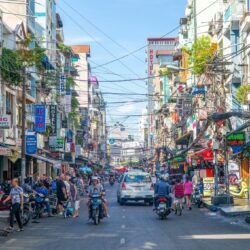
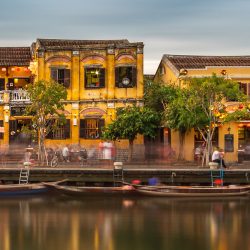
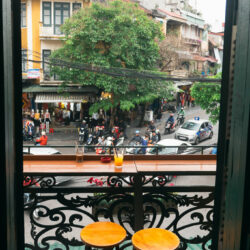
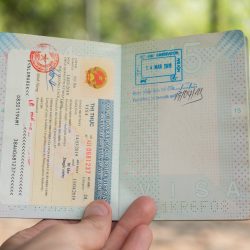




Hey Marek,
Loved your article it has been really helpful 🙂 Just a question – do I need proof that I will be leaving Vietnam upon entering (i.e. a return ticket)? Do you have any specific tips about visas etc.?
Thanks in advance!!
Hey Annie. I believe proof of onward travel is not a requirement for the visas (it’s only asked sometimes when using a visa exemption). Their visas have recently been made much simpler… I recommend applying for the new 90-day e-visa if you can. I have more info here 🙂
I’m heading to Vietnam soon and your article has been so helpful in the planning process. It was great to have the skeleton plan and then show alternatives for what different people may enjoy! I’m travelling with my husband (in20s) and my parents (60s) would you suggest that the hikes in sapa and along Ha long bay are manageable – my dad isn’t a fan of strenuous exercise unfortunately . Also wondering if you’ve done or know about Ha GIANG tours? Thanks again 🙂
Hey Sarah, glad this has been useful! Typically Ha Long Bay doesn’t involve real hiking, just maybe a 30-minute walk or so to a viewpoint for example, which if your dad truly doesn’t want to do he could skip by staying on the boat. The hikes in Sapa tend to be proper treks, at least moderate difficulty, so perhaps instead you could consider a homestay experience where you stay with a local family (lots of options for this in Sapa). Fansipan mountain also comes to mind, which has a cable car to the top.
I’ve explored Ha Giang by myself on a motorbike, which was one of my favorite travel experiences. There are so-called ‘easy rider’ tours where you’re on the back of a motorbike, if your folks are up for such an adventure! There are also tours by minibus. I haven’t done those but I think a lot of the experience may be lost there, as you just drive around and stop at a few viewpoints, without the full immersion you get from stopping in villages and having the wind in your face. But… I haven’t done it that way 🙂
Hi Marek, great article – inspired for my upcoming 3-week trip to Vietnam in May! I’ve booked return tickets to HCMC and was originally planning to travel this route up to Hanoi and then fly back down to HCMC at the end. Although I see many recommending to start in Hanoi and travel North-South. Would you recommend stopping in HCMC a couple of nights then catching a flight to Hanoi?
Hey Matt! It’s just a matter of preference. I’ve done things north to south twice now as I like starting in the mountains and ending in a warmer climate with more beaches. But either way works. I like Hanoi as a first introduction to Vietnam… it’s chaotic but it’s more traditional and has more heritage buildings than HCMC. Though if you do HCMC and Hanoi back to back, you may be desperate for some fresh air and crave a lack of motorbikes… I’d maybe bookend your trip with the two cities 🙂